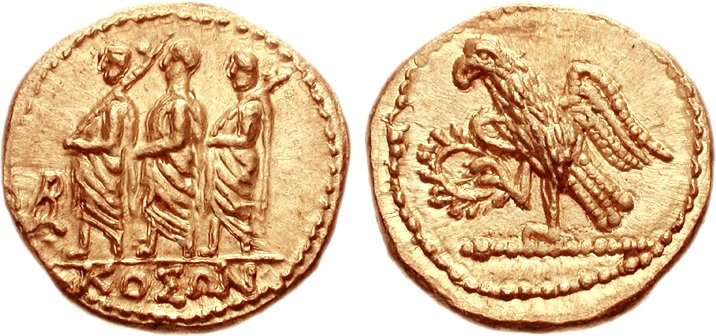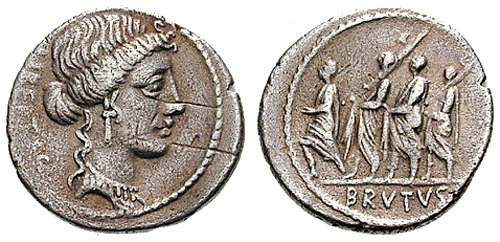Koson (coin) on:
[Wikipedia]
[Google]
[Amazon]
 The Kosons are the only gold coins that have been minted by the Dacians, named after the Greek alphabet inscription "ΚΟΣΩΝ" on them.Bogdan Constantinescu et al,
The Kosons are the only gold coins that have been minted by the Dacians, named after the Greek alphabet inscription "ΚΟΣΩΝ" on them.Bogdan Constantinescu et al,
Archaeometallurgical Characterization Of Ancient Gold Artifacts From Romanian Museums Using XRF, Micro-pixe And Micro-SR-XRF Methods
, in ''Proceedings Of The Romanian Academy" Series A, Volume 13, Number 1/2012, pp. 19–26 It is thought that "Koson" is the name of an otherwise historically unrecorded Dacian king, though he may be identical to the Cotison mentioned by
 The coins contain Roman iconography: on the obverse, there is an eagle standing on a
The coins contain Roman iconography: on the obverse, there is an eagle standing on a
 The Kosons are the only gold coins that have been minted by the Dacians, named after the Greek alphabet inscription "ΚΟΣΩΝ" on them.Bogdan Constantinescu et al,
The Kosons are the only gold coins that have been minted by the Dacians, named after the Greek alphabet inscription "ΚΟΣΩΝ" on them.Bogdan Constantinescu et al,Archaeometallurgical Characterization Of Ancient Gold Artifacts From Romanian Museums Using XRF, Micro-pixe And Micro-SR-XRF Methods
, in ''Proceedings Of The Romanian Academy" Series A, Volume 13, Number 1/2012, pp. 19–26 It is thought that "Koson" is the name of an otherwise historically unrecorded Dacian king, though he may be identical to the Cotison mentioned by
Horace
Quintus Horatius Flaccus (; 8 December 65 – 27 November 8 BC), known in the English-speaking world as Horace (), was the leading Roman lyric poet during the time of Augustus (also known as Octavian). The rhetorician Quintilian regarded his ' ...
and Suetonius
Gaius Suetonius Tranquillus (), commonly referred to as Suetonius ( ; c. AD 69 – after AD 122), was a Roman historian who wrote during the early Imperial era of the Roman Empire.
His most important surviving work is a set of biographies ...
.
Description
 The coins contain Roman iconography: on the obverse, there is an eagle standing on a
The coins contain Roman iconography: on the obverse, there is an eagle standing on a scepter
A sceptre is a staff or wand held in the hand by a ruling monarch as an item of royal or imperial insignia. Figuratively, it means royal or imperial authority or sovereignty.
Antiquity
Ancient Egypt and Mesopotamia
The ''Was'' and other ...
and holding a wreath in their claw (inspired by the silver denarii issued by Pomponius Rufus); the reverse contains three men dressed in togas, two of them holding an axe on the shoulder (possibly inspired by the silver denarii issued by Marcus Junius Brutus
Marcus Junius Brutus (; ; 85 BC – 23 October 42 BC), often referred to simply as Brutus, was a Roman politician, orator, and the most famous of the assassins of Julius Caesar. After being adopted by a relative, he used the name Quintus Serv ...
in 54 BC).
Discovery
Coins inscribed KOSON were discovered in several large stashes in Transylvania. The biggest group was discovered in 1543, and contained several thousands coins and objects made of gold. It was rumored that this stash was revealed in a bolted chamber under the riverStrei
The Strei ( hu, Sztrigy) is a left tributary of the river Mureș in Transylvania, Romania. The upper reach of the river, upstream of the village of Baru, is also known as ''Râul Petros''. It flows through the town Călan and the villages Petro ...
, identified as the river Sargetia
The Strei ( hu, Sztrigy) is a left tributary of the river Mureș (river), Mureș in Transylvania, Romania. The upper reach of the river, upstream of the village of Baru, Hunedoara, Baru, is also known as ''Râul Petros''. It flows through the tow ...
, and also mentioned by Dio Cassius
Lucius Cassius Dio (), also known as Dio Cassius ( ), was a Roman historian and senator of maternal Greek origin. He published 80 volumes of the history on ancient Rome, beginning with the arrival of Aeneas in Italy. The volumes documented the ...
. Further research disproved this, and placed the treasure in one of the Dacian castles in the Orăştie mountains, probably in Sarmisegetusa.
Debate regarding the name "Koson" was prompted after the discovery of the coins. The discovery captured the attention of writers at the time. Thus, there are comments from Erasmus of Rotterdam in 1520 and Stephanus Zamosius (István Szamosközy) in 1593.
King theory
Modern scholars agree that the name Koson most likely refers to a local king about whom nothing else is known. Vasile Pârvan argues that he was probably a Thracian dynast who employed the Dacian Getae tribe in plundering raids across the Danube, paying them in his coins. Theodor Mommsen argued that Koson was probably a Dacian ally of Brutus, since the coins seem to derive their imagery from those minted by Brutus himself. Recent scholars often argue that he is very likely to be identical to the " Cotison" mentioned byHorace
Quintus Horatius Flaccus (; 8 December 65 – 27 November 8 BC), known in the English-speaking world as Horace (), was the leading Roman lyric poet during the time of Augustus (also known as Octavian). The rhetorician Quintilian regarded his ' ...
(Odes III., 8, 18,) and Suetonius
Gaius Suetonius Tranquillus (), commonly referred to as Suetonius ( ; c. AD 69 – after AD 122), was a Roman historian who wrote during the early Imperial era of the Roman Empire.
His most important surviving work is a set of biographies ...
, (Augustus, 63.), a Dacian king during the reign of Augustus who had raided over the Danube.''The Numismatist: An Illustrated Monthly Magazine for Those Interested in Coins, Medals, and Paper Money'', Volume 25, 1912, p.333
References
External links
* {{Dacia topics Dacian kings 1st-century monarchs in Europe